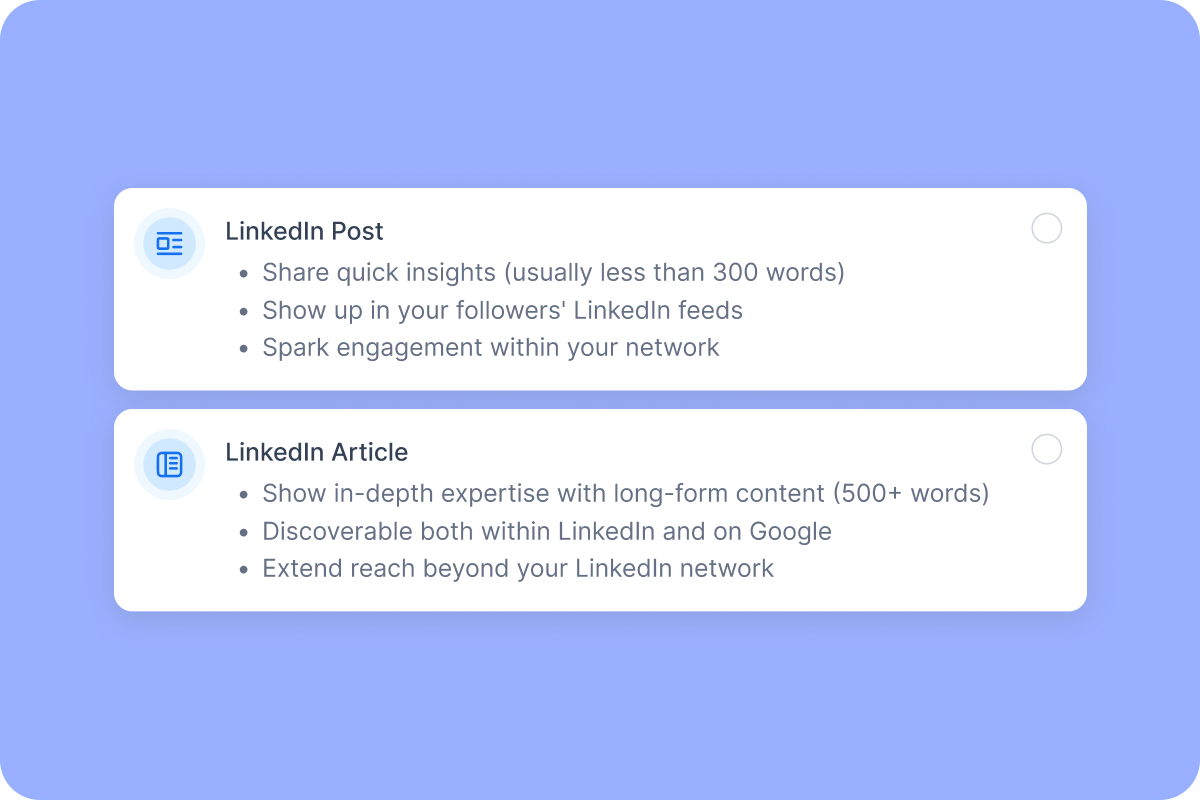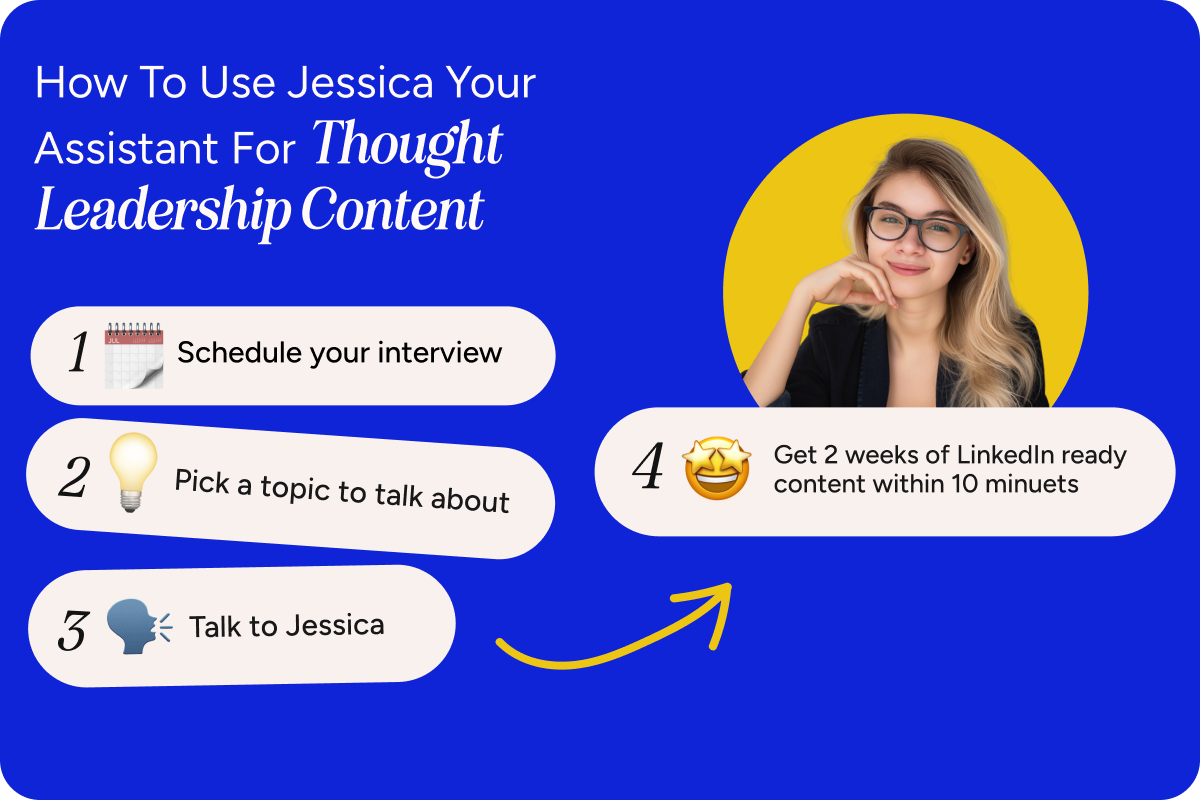As a professional looking to build your personal brand and share insights, LinkedIn offers two primary content types — posts and articles. But when aiming to boost credibility and connections, should you publish frequent short posts or in-depth long-form articles?
If you want to maximize your impact on LinkedIn, it’s not about choosing between quick posts and in-depth articles – it’s about using them strategically. Each format has its own strengths for building visibility, thought leadership, and connections.
This guide breaks down posts vs. articles, so you can create a LinkedIn strategy that leverages both to achieve your specific goals. We’ll cover everything from word count and audience expectations to how each format can boost your exposure and credibility.
LinkedIn Posts: Quick Takes on Timely Issues
Posts provide brief commentary, typically 300-500 words maximum. Their focused length appeals to professionals pressed for time.

Posts serve as bite-sized content to spark conversations by sharing:
- Thoughts on trending niche or industry news.
- Quick personal or professional updates.
- Links, images, or videos.
- Poll questions.
You can draft posts quickly to publish first takes on breaking developments. The casual format also allows spontaneity in tone and style.
The primary purposes of LinkedIn posts include:
- Demonstrate thought leadership: Opinions on the latest issues highlight your expertise.
- Increase awareness: Regular posts boost visibility and showcase your perspective.
- Spark engagement: Posts invite reactions, comments, and shares to widen reach.
- Strengthen relationships: Personal updates deepen existing connections.
Keep your insights timely and on-trend with Queue’s AI-powered topic discovery. No more guessing what your audience wants to talk about. Sign up for a 7-day free trial today.
LinkedIn Articles: Long Form Deep Dives
Need an expanded canvas for educating audiences or showcasing research? LinkedIn articles are the perfect vehicle, enabling long-form content exceeding 1,000+ words.

Ideal article content includes:
- Case studies
- How-to guides
- Professional storytelling
- Industry analysis or commentary
- Presenting original research and data
- Interviewing experts in written Q&A format
The extended word count allows drilling deeper into topics. Articles require planning outlines, conducting robust research, drafting & editing, and ultimately more time than posts.
But articles better cater to sophisticated audiences expecting you to back perspectives with substantiated evidence (think links to references, data, and proof) versus just opinions.
Goals achieved by publishing regular articles include:
- Educate and engage audiences through storytelling and data-based narratives.
- Convert visitors into leads by showcasing expertise around buyer pain points.
- Promote in-depth perspectives by directing your followers to detailed works.
- Establish niche thought leadership around specific issues.
Need help crafting a compelling case study or in-depth analysis? Let Queue’s AI writer assist with a polished, persuasive article written in your authentic voice.
Comparing Posts vs Articles
Now that we’ve outlined the core differences in purpose and content style, how do posts and articles stack up against one another side-by-side?
LinkedIn designed both content formats for engagement, but apps like Queue provide additional data revealing advantages unique to each medium.
Below is an overview of how posts and articles differ:
| Metric | Posts | Articles |
| Ideal Word Count | 300-500 | 1,000+ |
| Impressions and Engagement | High | Moderate |
| Reach and Lifespan | Strong short term reach | Slow burn long term reach |
| Backlinks & SEO | Minimal | Moderate |
| Shareability | Low | High |
| Lead Generation Power | Med | Med |
| Tag other creators | Yes | No |
| Visuals | Images, Videos, and Documents (carousels) | Images & Videos |
Ideal Word Count
Posts: Quick, concise, and to the point, LinkedIn posts are typically between 300-500 words, making them perfect for rapid consumption and frequent updates.
Articles: Designed for depth, LinkedIn articles thrive with 1,000+ words, offering space for comprehensive insights and thorough discussions on complex subjects.
Impressions and Engagement
Posts: LinkedIn posts are engagement powerhouses, often racking up high impression counts quickly due to their visibility on the newsfeed and ease of interaction.
Articles: Articles may garner moderate engagement initially but can become evergreen content that continues to attract attention and provoke thought over time.
Reach and Lifespan
Posts: With a strong short-term reach, LinkedIn posts excel at capturing immediate attention but typically have a brief lifespan in the fast-moving newsfeed.
Articles: Articles have a ‘slow burn’ effect, with a longer-term reach that builds momentum as they continue to be discovered and shared, often beyond the LinkedIn platform.
Backlinks & SEO
Posts: LinkedIn posts usually generate minimal backlinks since they’re not typically referenced as external sources due to their brief nature.
Articles: Articles hold more potential for garnering backlinks and can enhance your SEO efforts, especially when they contain valuable, cite-worthy content.
Shareability
Posts: LinkedIn posts have low shareability outside of LinkedIn, as they’re meant for quick reads within the platform itself.
Articles: High shareability is a strength of LinkedIn articles – their blog-like format makes them ideal for sharing across various platforms and communities, inviting external readership.
Lead Generation Power
Posts and Articles: Both formats hold medium potential for lead generation. Posts can prompt immediate action due to their high visibility, while articles build credibility over time, which can translate into leads.
Tagging Other Creators
Posts: Posts allow you to tag and mention other users, facilitating direct engagement and conversations with a broad range of LinkedIn users.
Articles: LinkedIn articles do not support tagging within the article content, focusing more on the message than on network interactions.
Visuals
Posts: The visual versatility of posts is unmatched. You can include images, videos, and documents like carousels to engage your audience visually.
Articles: While articles allow for images and videos, they lack the capability to include interactive elements like carousels, making them less dynamic than posts.
Volume and Value: A Simple LinkedIn Strategy
When developing a LinkedIn content strategy, you can leverage both posts and articles to build your authority. Below is an effective approach you can use for yourself to get the most out of your time on LinkedIn.
- Start by regularly publishing posts to engage your audience. These short pieces allow you to maintain a steady stream of content and consistency. Pay attention to which posts get the most impressions and engagement. This signals what topics your followers are most interested in.
- Once you identify a few high-performing post topics, turn those into in-depth articles. Transform the short-form ideas into comprehensive pieces, providing even more value on the topics your audience cares most about. Not only does this showcase your dedication through research and thought leadership, but it satisfies followers who want more on those popular subjects.
In this way, you can use posts and articles together strategically. Regular posts keep you top of mind and help inform potential high-performing article topics. Occasional articles then reinforce your expertise through deep dives on key themes.
Go beyond the standard metrics. Discover what content types truly resonate with those in your niche using Queue’s custom analytics.
In Summary: Strike an Impactful Mix of Posts and Articles
By understanding the nuances of posts and articles, you can tailor your content strategy to your strengths and audience preferences. Regular posts keep you top-of-mind, while articles establish you as the go-to expert in your niche.
Ready to level up your LinkedIn game? Queue helps you identify the hottest topics in your industry and turn them into engaging posts and articles effortlessly. Sign up for a Free Trial of Queue today to see the difference it makes!
Got questions? Write to us in the chat on our website (bottom right of the screen). We’ll be happy to help.



